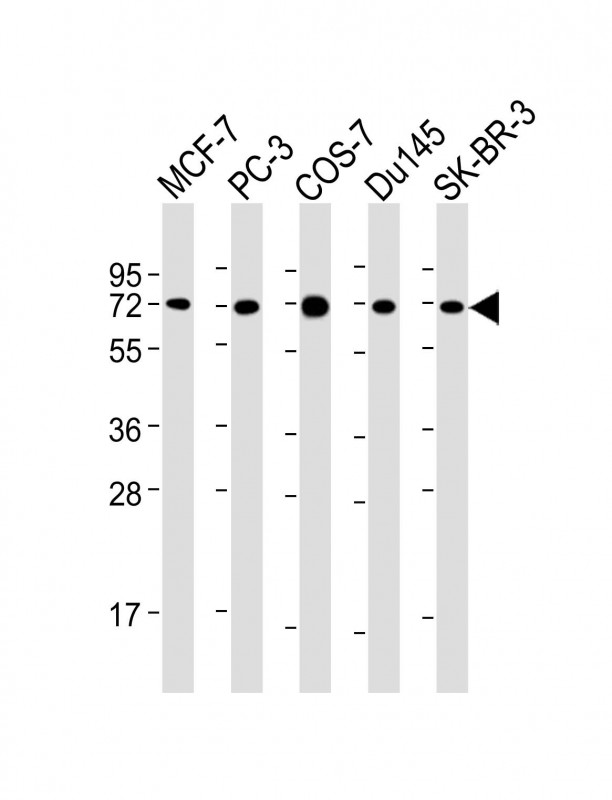USP2 Antibody
Purified Mouse Monoclonal Antibody (Mab)
- 产品详情
- 实验流程
- 背景知识
Application
| WB, E |
|---|---|
| Primary Accession | O75604 |
| Reactivity | Human, Green Monkey |
| Host | Mouse |
| Clonality | monoclonal |
| Isotype | IgG1,k |
| Clone Names | 1738CT331.50.87 |
| Calculated MW | 68072 Da |
| Gene ID | 9099 |
|---|---|
| Other Names | Ubiquitin carboxyl-terminal hydrolase 2, 3.4.19.12, 41 kDa ubiquitin-specific protease, Deubiquitinating enzyme 2, Ubiquitin thioesterase 2, Ubiquitin-specific-processing protease 2, USP2, UBP41 |
| Target/Specificity | This USP2 antibody is generated from a mouse immunized with a recombinant protein between 1-258 amino acids from human USP2. |
| Dilution | WB~~1:2000 E~~Use at an assay dependent concentration. |
| Format | Purified monoclonal antibody supplied in PBS with 0.09% (W/V) sodium azide. This antibody is purified through a protein G column, followed by dialysis against PBS. |
| Storage | Maintain refrigerated at 2-8°C for up to 2 weeks. For long term storage store at -20°C in small aliquots to prevent freeze-thaw cycles. |
| Precautions | USP2 Antibody is for research use only and not for use in diagnostic or therapeutic procedures. |
| Name | USP2 |
|---|---|
| Synonyms | UBP41 |
| Function | Hydrolase that deubiquitinates polyubiquitinated target proteins such as MDM2, MDM4 and CCND1 (PubMed:17290220, PubMed:19838211, PubMed:19917254). Isoform 1 and isoform 4 possess both ubiquitin-specific peptidase and isopeptidase activities (By similarity). Deubiquitinates MDM2 without reversing MDM2-mediated p53/TP53 ubiquitination and thus indirectly promotes p53/TP53 degradation and limits p53 activity (PubMed:17290220, PubMed:19838211). Has no deubiquitinase activity against p53/TP53 (PubMed:17290220). Prevents MDM2-mediated degradation of MDM4 (PubMed:17290220). Plays a role in the G1/S cell-cycle progression in normal and cancer cells (PubMed:19917254). Regulates the circadian clock by modulating its intrinsic circadian rhythm and its capacity to respond to external cues (By similarity). Associates with clock proteins and deubiquitinates core clock component PER1 but does not affect its overall stability (By similarity). Regulates the nucleocytoplasmic shuttling and nuclear retention of PER1 and its repressive role on the clock transcription factors CLOCK and BMAL1 (By similarity). Plays a role in the regulation of myogenic differentiation of embryonic muscle cells (By similarity). |
| Cellular Location | Cytoplasm {ECO:0000250|UniProtKB:O88623}. Cytoplasm, perinuclear region {ECO:0000250|UniProtKB:O88623} Note=Localizes in the spermatid head in late-elongating spermatids in the thin area between the outer acrosomal membrane and the plasma membrane. {ECO:0000250|UniProtKB:Q5U349} |
| Tissue Location | Expressed in mesangial cells of the kidney and in different types of glomerulonephritides (at protein level) |
For Research Use Only. Not For Use In Diagnostic Procedures.
Provided below are standard protocols that you may find useful for product applications.
BACKGROUND
Hydrolase that deubiquitinates polyubiquitinated target proteins such as MDM2, MDM4 and CCND1. Isoform 1 and isoform 4 possess both ubiquitin-specific peptidase and isopeptidase activities. Deubiquitinates MDM2 without reversing MDM2-mediated p53/TP53 ubiquitination and thus indirectly promotes p53/TP53 degradation and limits p53 activity. Has no deubiquitinase activity against p53/TP53. Prevents MDM2-mediated degradation of MDM4. Plays a role in the G1/S cell-cycle progression in normal and cancer cells. Plays a role in the regulation of myogenic differentiation of embryonic muscle cells. Regulates the circadian clock by modulating its intrinsic circadian rhythm and its capacity to respond to external cues. Associates with clock proteins and deubiquitinates core clock component PER1 but does not affect its overall stability. Regulates the nucleocytoplasmic shuttling and nuclear retention of PER1 and its repressive role on the clock transcription factors CLOCK and ARNTL/BMAL1 (By similarity).
REFERENCES
Gong L.,et al.Submitted (JUL-1998) to the EMBL/GenBank/DDBJ databases.
Rossi S.,et al.Submitted (OCT-2001) to the EMBL/GenBank/DDBJ databases.
Ota T.,et al.Nat. Genet. 36:40-45(2004).
Taylor T.D.,et al.Nature 440:497-500(2006).
Mural R.J.,et al.Submitted (JUL-2005) to the EMBL/GenBank/DDBJ databases.
终于等到您。ABCEPTA(百远生物)抗体产品。
点击下方“我要评价 ”按钮提交您的反馈信息,您的反馈和评价是我们最宝贵的财富之一,
我们将在1-3个工作日内处理您的反馈信息。
如有疑问,联系:0512-88856768 tech-china@abcepta.com.























 癌症的基本特征包括细胞增殖、血管生成、迁移、凋亡逃避机制和细胞永生等。找到癌症发生过程中这些通路的关键标记物和对应的抗体用于检测至关重要。
癌症的基本特征包括细胞增殖、血管生成、迁移、凋亡逃避机制和细胞永生等。找到癌症发生过程中这些通路的关键标记物和对应的抗体用于检测至关重要。 为您推荐一个泛素化位点预测神器——泛素化分析工具,可以为您的蛋白的泛素化位点作出预测和评分。
为您推荐一个泛素化位点预测神器——泛素化分析工具,可以为您的蛋白的泛素化位点作出预测和评分。 细胞自噬受体图形绘图工具为你的蛋白的细胞受体结合位点作出预测和评分,识别结合到自噬通路中的蛋白是非常重要的,便于让我们理解自噬在正常生理、病理过程中的作用,如发育、细胞分化、神经退化性疾病、压力条件下、感染和癌症。
细胞自噬受体图形绘图工具为你的蛋白的细胞受体结合位点作出预测和评分,识别结合到自噬通路中的蛋白是非常重要的,便于让我们理解自噬在正常生理、病理过程中的作用,如发育、细胞分化、神经退化性疾病、压力条件下、感染和癌症。






